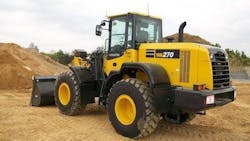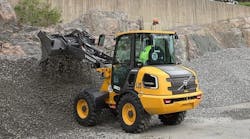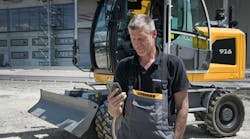Two key factors determine how fast a properly sized wheel loader can load trucks—the trucks' position relative to loading face, and how well the operator fills the bucket with each pass. Construction sites present some challenges that aren't found on a mine's loading floor, but most obstacles can be overcome. Barely perceptible losses in loader efficiency can be quite costly.
Suppose, for example, a 3-cubic-yard loader is loading a mixture of rock and dirt from a loose stockpile into 9-cubic-yard trucks. On a decent loading surface, a good operator can fill a bucket, dump it into a truck and get back to the face in 30 seconds. Assuming there are 50 minutes of work in every hour, you'd expect to move 133 truckloads in a morning. But suppose the trucks aren't spotted properly and the operator isn't employing the loader's full power to fill the bucket quickly, and cycle time increases by 20 percent—adding just six seconds to each pass. You move 111 truckloads in four hours. That's 22 fewer trucks, leaving nearly 200 cubic yards of material on the pile.
It's not hard to fill a bucket to 100 percent of its rated capacity in these conditions. But if the operator can only manage 85 percent bucket fill, it'll take three and a half passes to fill the trucks. Choose to send the trucks after three passes with just 7.65 cubic yards on board and you'll move 1,017 cubic yards in four hours (about 180 yards less than optimal production). Or overload the trucks by more than a cubic yard with four bucket loads and move 1,020 yards in four hours.
"You have to start by matching the loader to the trucks," says Toby Welch, senior demonstrator/instructor at Caterpillar's Tinaja Hills training center. "Two to three passes of the loader to fill the truck is optimal."
Once you have the right equipment, the best opportunity to safely improve productivity comes in planning.
"The wheel loader operator has to look at the whole face where he's doing loading, and plan the best way to bring in the trucks and work the face," says Marty Dains, training coordinator of Cat's Equipment Training Solutions group. "He needs to take control of the loading area and spot trucks where he can get the best production."
Fill a bucket and hoist it over the spot where you want the dump body. The trucker should drive underneath the bucket.
Put the trucks as close as possible to the spot where the loader is working, at a 30- to 45-degree angle to the loading face. The loader should be able to approach the loading face squarely, back away from the loading face, change direction, and drive forward to the dump box, arriving with less than a 5-degree angle in its articulation joint. Caterpillar recommends that the loader's wheels should turn only about 1.5 revolutions on each side of this tight V-shaped pattern.
"You want to work from one side to the other, usually left to right across the face," says Dains. "Open a space up in the face against one end and then back the second truck, and all those following, into the hole you've created. It places them closer to the work.
"If there's a conveyor building the stockpile, be careful not to put the trucks in a position where material can slough off the pile onto them.
"Truck placement can be a little more difficult on construction sites," says Dains, "where there might be piles of material around here and there and they're loading different kinds of trucks, like tri-axles and tractor-trailers, or rear dumps and belly dumps."
Tractor-trailer combinations can be harder to back into position. It can be better to pull trailers through close to the face, between it and the loader. They can turn sharply away from the face to create the shallow angle with the dump bed.
"You may not have radio communication with hauling contractors," says Dains. "So if you don't have a CB in the loader, you have to rely on hand signals and horns.
"If you need to, stop for a couple minutes and talk to truck drivers to get things set up at the face. You'll be surprised at how quickly you'll make up that time with the right planning."
Quickly moving the truck close to the face is critical.
"You only need enough travel time to raise the bucket to dump, and then get it back down on the floor before you reach the pile," according to a videotape called "Tips from the Pros: Wheel Loader" from VISTA Training.
Set the throttle at high idle to get a loader's best hydraulic performance.
"The power train, hydraulics and cooling system are at their most efficient at high idle," says Dains. "Decelerate with the neutralizer pedal or impeller clutch when necessary.
"You need to run in first gear," he adds. "Machines are designed so that the hydraulic speeds are matched for loading when you're operating in first."
Fill the bucket starting flat on the loading floor.
"A lot of guys will fill the first bucket from a couple of feet off the floor," says Dains. "But the lower third of the loader's lifting range is where the machine is most efficient."
It's a problem that can be minimized by the return-to-dig setting.
"Set the lower hoist kick out so that when you're coming out of the truck and back to the loading face, you push the boom lever forward to a detent and it lowers the bucket to a preset height," says Welch. "If you set it 6 to 8 inches off the ground, it only takes a slight movement just before you go into the pile to get the bucket down on the floor."
If you're loading sized material from a stockpile, Welch warns against dropping the bucket to the ground too soon. You don't want to contaminate the stone with material off the loading floor.
Return-to-dig takes the guesswork out of leveling the bucket to penetrate the face. Go into the pile with the bucket flat or parallel to the floor. As your forward progress begins to slow, just before the tires begin to spin, boom up to transfer weight to the front tires. Keep hoisting until the bucket is full, and then tip the bucket back to retain the load.
Curling the bucket before booming up puts pressure on the heel of the bucket, which accelerates wear on that area and actually unloads the front tires. Traction suffers.
"The key is to keep that bucket moving through the face—to keep filling the bucket," says Dains.
In tough digging, such as a bank or consolidated stockpile, judicious use of bucket breakout force can help keep the bucket moving and fill it more completely.
"Once the machine can't handle the hoist (hydraulics begin to stall), you need to curl just a bit, and continue to hoist," says Dains. "First penetrate the pile and hoist as much as you can, then curl a bit, then hoist again, then curl a bit, then hoist again. If the bucket stops moving, you need to either curl or hoist until it's full."
Sometime during the process, continuing to crowd the pile with the transmission serves only to rob hydraulic power. Stop pushing before the tires spin using the transmission disconnect, sometimes known as a neutralizer pedal or impellor clutch. With the neutralizer turned on, stepping on the left brake pedal disengages the transmission. You can slow the machine and still maintain engine speed for peak hydraulic performance.
"The bucket should be loaded by the time the loader arms are halfway through their range of travel, or about parallel to ground," says Dains.
Never back a wheel loader without looking behind you first. Setting the boom-height kick out to hoist the bucket just high enough to make the dump automates the boom function so you can concentrate on backing and maneuvering the machine safely.
Operators need to know how many buckets it takes to fill each kind of truck being loaded and where to place those buckets.
"Center the load right to left and distribute it evenly from front to rear, especially on highway trucks," says Dains. "The DOT really watches axle splits. You want to carry maximum capacity, but you don't want to get nailed for being overloaded on one axle."
A wheel loader is one of the most mobile heavy machines on any construction project. It can be employed all over a site, doing all kinds of tasks, and working in reverse nearly half the time. VISTA's "Tips from the Pros" video stresses the importance of knowing site details such as where people are entering and exiting the work area, where haul trucks are running, and where the other trades are working.
Choose travel routes for load-and-carry operations carefully, and prepare them to prevent spillage. Protect curbs or apron edges with a ramp of gravel or clean soil. Use ride control, if the loader's equipped, and carry the load as low as possible in transit.
When setting pipe, always follow OSHA sling and lifting guidelines. A boom attachment in place of the bucket will help keep the machine back from the trench wall.
"If you don't have a lift chart, you must do test lifts to make sure the machine can safely handle the load on the hook," says Dains.
When backfilling, stay back from the edge of the trench as far as possible. Keep the bucket on the ground, using it like a dozer to push spoil into the trench. To extend the machine's reach, you can even use one pile to push another pile into the trench. Just keep the bucket full and move the material in front of the bucket.
Equipment dealers, manufacturers, and third parties like VISTA and operators' unions will likely know of more ways to refine the safety and productivity of a loader operator who already knows the basics. The closer you can come to recreating textbook conditions in the real world, the more profitably your loaders will work.





